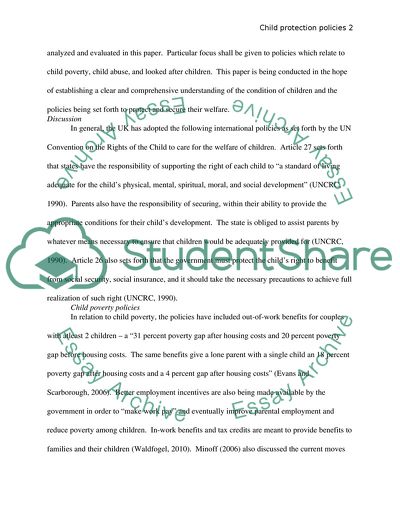Cite this document
(Child Protection Policies Research Paper Example | Topics and Well Written Essays - 2500 words - 1, n.d.)
Child Protection Policies Research Paper Example | Topics and Well Written Essays - 2500 words - 1. Retrieved from https://studentshare.org/social-science/1750032-essay-title-analyse-and-evaluate-contemporary-social-policy-in-relation-to-the-welfare-of-young-children-and-their-families-your-essay-should-focus-on-child-poverty-child-abuse-and-looked-after-children
Child Protection Policies Research Paper Example | Topics and Well Written Essays - 2500 words - 1. Retrieved from https://studentshare.org/social-science/1750032-essay-title-analyse-and-evaluate-contemporary-social-policy-in-relation-to-the-welfare-of-young-children-and-their-families-your-essay-should-focus-on-child-poverty-child-abuse-and-looked-after-children
(Child Protection Policies Research Paper Example | Topics and Well Written Essays - 2500 Words - 1)
Child Protection Policies Research Paper Example | Topics and Well Written Essays - 2500 Words - 1. https://studentshare.org/social-science/1750032-essay-title-analyse-and-evaluate-contemporary-social-policy-in-relation-to-the-welfare-of-young-children-and-their-families-your-essay-should-focus-on-child-poverty-child-abuse-and-looked-after-children.
Child Protection Policies Research Paper Example | Topics and Well Written Essays - 2500 Words - 1. https://studentshare.org/social-science/1750032-essay-title-analyse-and-evaluate-contemporary-social-policy-in-relation-to-the-welfare-of-young-children-and-their-families-your-essay-should-focus-on-child-poverty-child-abuse-and-looked-after-children.
“Child Protection Policies Research Paper Example | Topics and Well Written Essays - 2500 Words - 1”, n.d. https://studentshare.org/social-science/1750032-essay-title-analyse-and-evaluate-contemporary-social-policy-in-relation-to-the-welfare-of-young-children-and-their-families-your-essay-should-focus-on-child-poverty-child-abuse-and-looked-after-children.


